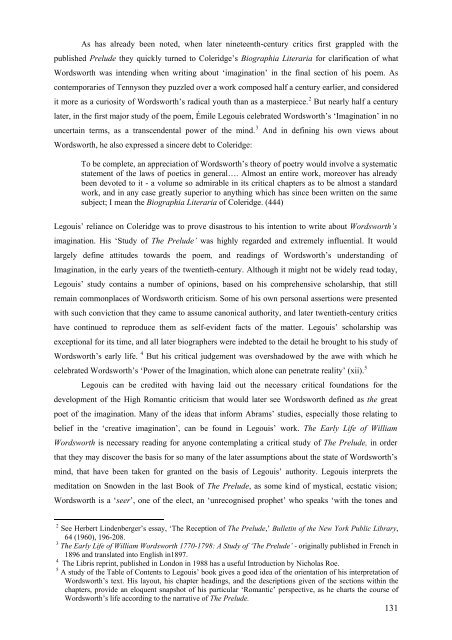Contents - ResearchSpace@Auckland - The University of Auckland
Contents - ResearchSpace@Auckland - The University of Auckland
Contents - ResearchSpace@Auckland - The University of Auckland
You also want an ePaper? Increase the reach of your titles
YUMPU automatically turns print PDFs into web optimized ePapers that Google loves.
As has already been noted, when later nineteenth-century critics first grappled with thepublished Prelude they quickly turned to Coleridge’s Biographia Literaria for clarification <strong>of</strong> whatWordsworth was intending when writing about ‘imagination’ in the final section <strong>of</strong> his poem. Ascontemporaries <strong>of</strong> Tennyson they puzzled over a work composed half a century earlier, and consideredit more as a curiosity <strong>of</strong> Wordsworth’s radical youth than as a masterpiece. 2 But nearly half a centurylater, in the first major study <strong>of</strong> the poem, Émile Legouis celebrated Wordsworth’s ‘Imagination’ in nouncertain terms, as a transcendental power <strong>of</strong> the mind. 3 And in defining his own views aboutWordsworth, he also expressed a sincere debt to Coleridge:To be complete, an appreciation <strong>of</strong> Wordsworth’s theory <strong>of</strong> poetry would involve a systematicstatement <strong>of</strong> the laws <strong>of</strong> poetics in general…. Almost an entire work, moreover has alreadybeen devoted to it - a volume so admirable in its critical chapters as to be almost a standardwork, and in any case greatly superior to anything which has since been written on the samesubject; I mean the Biographia Literaria <strong>of</strong> Coleridge. (444)Legouis’ reliance on Coleridge was to prove disastrous to his intention to write about Wordsworth’simagination. His ‘Study <strong>of</strong> <strong>The</strong> Prelude’ was highly regarded and extremely influential. It wouldlargely define attitudes towards the poem, and readings <strong>of</strong> Wordsworth’s understanding <strong>of</strong>Imagination, in the early years <strong>of</strong> the twentieth-century. Although it might not be widely read today,Legouis’ study contains a number <strong>of</strong> opinions, based on his comprehensive scholarship, that stillremain commonplaces <strong>of</strong> Wordsworth criticism. Some <strong>of</strong> his own personal assertions were presentedwith such conviction that they came to assume canonical authority, and later twentieth-century criticshave continued to reproduce them as self-evident facts <strong>of</strong> the matter. Legouis’ scholarship wasexceptional for its time, and all later biographers were indebted to the detail he brought to his study <strong>of</strong>Wordsworth’s early life. 4 But his critical judgement was overshadowed by the awe with which hecelebrated Wordsworth’s ‘Power <strong>of</strong> the Imagination, which alone can penetrate reality’ (xii). 5Legouis can be credited with having laid out the necessary critical foundations for thedevelopment <strong>of</strong> the High Romantic criticism that would later see Wordsworth defined as the greatpoet <strong>of</strong> the imagination. Many <strong>of</strong> the ideas that inform Abrams’ studies, especially those relating tobelief in the ‘creative imagination’, can be found in Legouis’ work. <strong>The</strong> Early Life <strong>of</strong> WilliamWordsworth is necessary reading for anyone contemplating a critical study <strong>of</strong> <strong>The</strong> Prelude, in orderthat they may discover the basis for so many <strong>of</strong> the later assumptions about the state <strong>of</strong> Wordsworth’smind, that have been taken for granted on the basis <strong>of</strong> Legouis’ authority. Legouis interprets themeditation on Snowden in the last Book <strong>of</strong> <strong>The</strong> Prelude, as some kind <strong>of</strong> mystical, ecstatic vision;Wordsworth is a ‘seer’, one <strong>of</strong> the elect, an ‘unrecognised prophet’ who speaks ‘with the tones and2 See Herbert Lindenberger’s essay, ‘<strong>The</strong> Reception <strong>of</strong> <strong>The</strong> Prelude,’ Bulletin <strong>of</strong> the New York Public Library,64 (1960), 196-208.3 <strong>The</strong> Early Life <strong>of</strong> William Wordsworth 1770-1798: A Study <strong>of</strong> ‘<strong>The</strong> Prelude’ - originally published in French in1896 and translated into English in1897.4 <strong>The</strong> Libris reprint, published in London in 1988 has a useful Introduction by Nicholas Roe.5 A study <strong>of</strong> the Table <strong>of</strong> <strong>Contents</strong> to Legouis’ book gives a good idea <strong>of</strong> the orientation <strong>of</strong> his interpretation <strong>of</strong>Wordsworth’s text. His layout, his chapter headings, and the descriptions given <strong>of</strong> the sections within thechapters, provide an eloquent snapshot <strong>of</strong> his particular ‘Romantic’ perspective, as he charts the course <strong>of</strong>Wordsworth’s life according to the narrative <strong>of</strong> <strong>The</strong> Prelude.131














